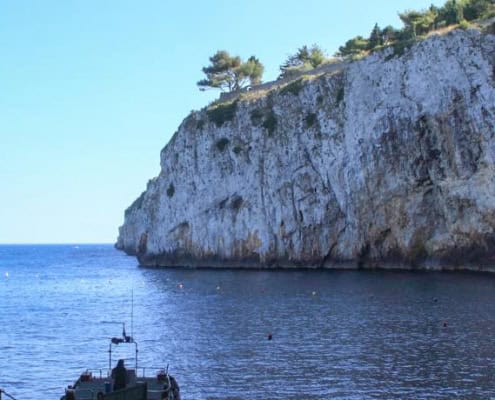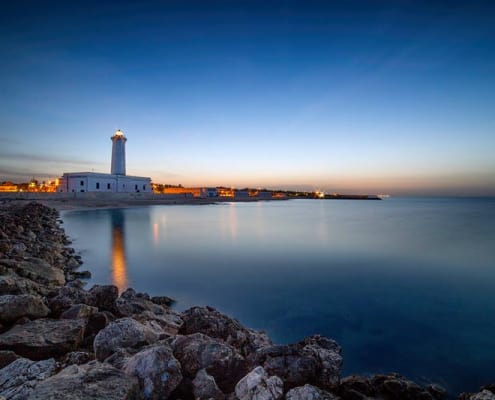NEIGHBORHOOD
STROLLING AROUND THE HOTEL ORSA MAGGIORE
Castro
Known, since ancient times, for being a thriving center of important commercial exchange, but above all for the imposing fortress that stood on the sea, Castro can be divided into two parts.
On the one hand, in fact, we have Castro Marina - in a scenic panoramic position - the place where the renowned marina is located and the starting point for discovering the Grotta Zinzulusa and Grotta Romanelli. On the other side, however, we find the village of Castro Superiore, overlooking the sea, extending over a vast hilly area, rich in architectural jewels of great historical value.
What to see in Castro
Choosing what to visit in Castro, one can only start from Castle. Built in the 13th century, on the remains of a Byzantine fortress, the Castle is the most panoramic point of Castro, overlooking the infinite blue of the sea and the green of the vegetation.
In the center, there is also the Cathedral: dating back to the 12th century, the church retains the Romanesque appearance in the facade, in the transept and in the right portal, while on the left side it incorporates the remains of a Byzantine church. Not to be missed, a visit to the many caves of Castro, ravines where the sea takes on silvery shades.
Monuments and a past rich in history make Castro a place to be experienced in its entirety.
Otranto (just 20 min from Castro)
Known by tourists for the beauty of its coasts, the so-called "Byzantium of Salento", the city of Otranto offers, in the still intact medieval core, a scenario of enchanting beauty: on the winding alleys, surrounded by the high Aragonese walls, which still recall the strenuous fight that the Idruntini waged against the Turks, dominate the solemn Norman Cathedral, the small Byzantine church of S. Pietro, and the Aragonese Castle.
But the beauties of Otranto are not limited to the old village and the historical importance of its artistic treasures. One of the main attractions of the city of martyrs, is in fact the incomparable seaside and the splendid natural scenery.
Moving along the coast road to the north, within a few kilometers, we find bathing sites characterized by fantastic nature and fairytale settings: the Baia dei Turchi, the historic landing place of the Turkish soldiers, with its Caribbean-like beach and clear waters like few others, it will seem to be truly in the Caribbean! The Alimini Lakes, two splendid basins, one of fresh water, and the other salty, fed by different sources and surrounded by a fantastic Mediterranean scrub and introduced by a very white stretch of sand. Or the highest and most rocky part of Torre Sant'Andrea and Torre dell'Orso, where the coast takes the characteristic shape of huge inlets which, through the incessant action of the wind, appear as large bays of smooth, softened, carved rocks. Then the typical stacks that rise from the sea are beautiful, creating games of shapes and legendary stories, such as the mythical rock of the 'Two Sisters'.
Immersion in nature along the paths of Ciolo and Cipolliane
For all those travelers who are not satisfied with the crystal clear sea, the splendid Salento beaches and who want to slowly explore the natural beauties of the Italian heel, Salento has so much to offer. A few kilometers from Santa Maria di Leuca, in the extreme south of Salento, is Località Ciolo, a small natural jewel renowned for the panoramic bridge that rises between two fjords overlooking the sea.
Immersed in the wild nature of this place, between Mediterranean scrub, dry stone walls and breathtaking views of the endless Adriatic table, there are two paths to be taken on foot in a suggestive and incomparable atmosphere. These are the Path of the Ciolo and the Path of the Cipolliane.
This location is also very popular with climbing enthusiasts who, with the right equipment and a good dose of courage, climb the rocks in an incredibly evocative setting.
Curiosities and historical notes
The Path of the Cipolliane extends for a length of just under 3 km and the landscape that those who walk it can admire, is that typical of the Salento countryside: in fact, you can find the typical dry stone walls and the characteristic vegetation of the Mediterranean scrub.
The Sentiero del Ciolo, about 4 km long, starts from a square a few steps from the center of Gagliano del Capo, where you can park your car or your bike and walk towards the sea.



